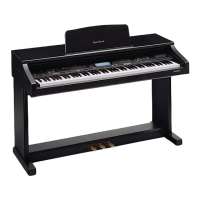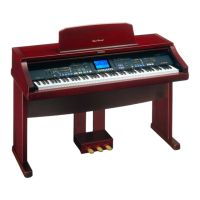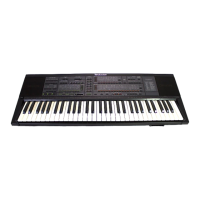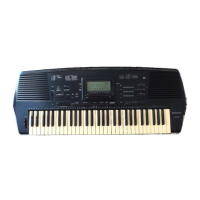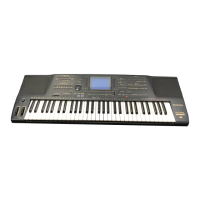
Do you have a question about the Technics SX-PR900B and is the answer not in the manual?
| Brand | Technics |
|---|---|
| Model | SX-PR900B |
| Category | Electronic Keyboard |
| Language | English |
Critical safety warning against exposure to water and electrical hazards.
Introduces the owner's manual structure and encourages thorough reading.
Details on protecting hearing and precautions against water ingress.
Instructions for requesting service and general maintenance procedures.
Overview of Play Style, Composer, and Rhythm Group controls on the PR700.
Explanation of DEMO, Piano Stylist, and One Touch Play functions.
Details on LCD display, Sequencer, Sound Group, and Effects.
Information regarding the instrument's backup memory functionality.
Overview of Play Style, Composer, and Rhythm Group controls on the PR900.
Explanation of DEMO, Piano Stylist, and One Touch Play functions.
Details on LCD display, Sequencer, Sound Group, and Effects.
Information on tuning and general maintenance for the PR900.
Steps for connecting power, turning on, and initial keyboard interaction.
Instructions for setting up the keyboard cover and music stand.
Guide on how to listen to pre-programmed sound demonstrations.
Guide on how to listen to pre-programmed style demonstrations.
Instructions for selecting and activating the Piano Mode.
Guide on choosing from four different piano sound types.
Steps to select sounds using the Conductor and Sound Group features.
Instructions for applying the DIGITAL REVERB effect.
Guide to choosing rhythm groups and their variations.
How to start, stop, and control the rhythm playback.
Methods for adjusting the rhythm tempo via dial or tap.
Instructions for inserting introduction and fill-in rhythm patterns.
Instructions for inserting an ending rhythm pattern.
Using Piano Stylist with a specific tune for accompaniment.
Guide on selecting accompaniment styles from the display.
How to play chords with the left hand and melody with the right.
Stopping the performance and how auto accompaniment behaves.
Steps to insert a disk and initiate Direct Play mode.
Guide on selecting songs from the list for playback.
Final steps to start playing a selected song from the disk.
Explanation of the standard display view showing rhythm and sound information.
How to adjust volume balance for different parts using bar graphs.
Details on display elements like Rhythm, Metronome, Page buttons, and Menu.
Illustrations of menu and specific setting displays like Sound Setting.
Functions of the EXIT, DISPLAY HOLD, and CONTRAST buttons.
Using the TEMPO/PROGRAM dial and accessing the HELP display.
Exploring different performance styles like Piano Mode.
Using the Conductor and selecting various instrument sounds.
Choosing sound groups for different parts of the instrument.
Using the Digital Drawbar for sound shaping and effects.
Adjusting drawbar parameters like decay and attack time.
Combining sounds for two parts and splitting the keyboard.
Setting the split point for different sounds on the keyboard.
Understanding the Sustain, Sostenuto, and Soft pedals.
Adjusting the string resonance for piano sounds.
Applying and adjusting Digital and DSP effects for sound enhancement.
Adjusting Brilliance for brightness and Digital Reverb for ambiance.
Changing the pitch of songs to different keys.
Using the Techni-chord for automatic harmony accompaniment.
Guide on choosing rhythm groups and individual rhythms.
Setting up the metronome and starting rhythm playback.
Methods for adjusting tempo and controlling rhythm playback.
Adding introductory, fill-in, and ending patterns to rhythms.
Using the Auto Play Chord for automatic accompaniment.
How the Auto Play Chord feature works and its components.
Techniques for playing chords using different modes.
Exploring various chord modes like Basic, Fingered, and Advanced.
Detailed guide on using the Auto Play Chord feature effectively.
Adjusting volume balance for the Auto Play Chord parts.
Using the Piano Stylist to select styles and register performances.
Using One Touch Play for instant sound and rhythm registration.
Selecting music styles for registration and performance.
Creating and arranging music styles for performances.
Storing and recalling panel settings for quick access.
Exploring Panel Memory modes and the Expand Mode Filter.
Configuring the soft pedal and sostenuto pedal settings.
Introduction to the sequencer, its capabilities, and features.
Detailed explanation of sequencer features and measure count.
How to navigate the sequencer menu and its summary.
Summary of all available functions within the Composer menu.
Procedure for selecting songs and assigning names within the sequencer.
Using the Easy Record mode for quick song recording.
How to play back recorded songs and manage playback.
Assigning parts to tracks within the sequencer.
Step-by-step guide for realtime song recording.
Using cycle recording for continuous note input.
Managing sequencer playback, including track selection.
Controlling cycle playback, including start and end measures.
Recording notes one-by-one using the step record feature.
Saving control data such as velocity and pitch.
Recording chord progressions using the sequencer.
Recording rhythm progressions and their timing.
Correcting recorded rhythm progressions and timing.
Assigning sequencer tracks to different parts like drums or chords.
Overview of editing functions for recorded performances.
Choosing specific edit functions like Note Edit or Drum Edit.
Detailed steps for editing individual notes in a recording.
Editing drum parts, including note velocity and length.
Correcting the timing of recorded notes using Quantize.
Adjusting pitch (Transpose) and note velocity.
Erasing songs or specific tracks from the sequencer memory.
Modifying note pitch and adjusting timing with Advance/Delay.
Copying songs and merging tracks within the sequencer.
Writing panel settings and copying measures in the sequencer.
Erasing or deleting specific measures from a track.
Inserting measures into a recorded sequence.
Recording sections of a performance using Punch Record.
Using Auto Punch Record for automatic punch-in/out recording.
Playing back songs sequentially as a medley.
Introduction to the Composer function for creating rhythms and accompaniments.
Storing up to 12 different rhythm patterns in memory banks.
Information on the total memory capacity for composer patterns.
How to access and navigate the Composer Record menu.
Summary of all available functions within the Composer menu.
Overview of three methods for creating and recording rhythms.
Creating unique rhythm patterns using styles and variations.
Modifying preset rhythm patterns and copying data.
Steps for creating a completely new rhythm from scratch.
Storing rhythm pattern data by performing it on the keyboard.
Playing back recorded rhythm patterns and managing playback.
Recording notes one-by-one using the step record feature.
Choosing between Normal and Expand modes for composer patterns.
Creating and storing chord maps for accompaniment patterns.
Loading stored chord maps for use with performances.
Introduction to the disk drive for storing and loading data.
Details on internal storage and the floppy disk drive.
Procedures for loading software from disks.
Immediate playback of commercial songs from disk.
General steps for operating the disk drive functions.
Instructions for loading data from floppy disks.
Instructions for loading Standard MIDI Files.
Loading individual composer patterns into memory.
Guide to playing commercial songs from disk.
Procedure for formatting floppy disks for use.
General information on saving data to disk.
Steps for saving data to a floppy disk.
Steps for saving MIDI files to disk.
Navigating the sound mode menu to adjust sound settings.
Overview of functions within the sound menu.
Adjusting attributes for individual instrument parts.
Adjusting volume and stereo balance for instrument parts.
Modifying reverb, DSP effects, and sustain parameters.
Adjusting key shift for pitch and fine-tuning the instrument.
Configuring pitch bend range and other miscellaneous settings.
Using the mixer to adjust volume and balance of parts.
Setting keyboard touch response sensitivity levels.
Adjusting the overall master tuning of the instrument.
Customizing key scaling for different temperament types.
Choosing Techni-chord styles for harmony.
Controlling how the left section sustains notes in Auto Play Chord.
Detailed settings for Reverb and DSP effects.
Explanation of MIDI and its role in digital instrument communication.
Details on MIDI input/output terminals and connection examples.
Understanding MIDI channels and data types like Note and Control Change.
Information on the General MIDI standard for instrument compatibility.
Overview of the various MIDI functions available on the instrument.
How to configure basic MIDI channel settings.
Assigning MIDI channels to parts and configuring channel transmission.
Enabling or disabling various control messages via MIDI.
Configuring octave shift and local control for MIDI.
Managing realtime messages and clock synchronization.
Setting common parameters like Note, Program Change, and Transpose.
Setting up MIDI presets for master/slave configurations.
Configuring input/output settings for MIDI data transmission.
Outputting Techni-chord and Drum pattern data via MIDI.
Transmitting Auto Play Chord data for accompaniment.
Configuring the instrument for General MIDI mode.
Setting panel memory output parameters for transmission.
Steps to reset the instrument to factory default settings.
Description of audio outputs, MIDI ports, and auxiliary inputs.
Information on headphone output and pedal connections.
Steps for unpacking and identifying parts for PR700 assembly.
Instructions for attaching the piano body to the stand and installing the speaker.
Procedure for connecting the pedal unit and power cables.
Steps for unpacking and identifying parts for PR900 assembly.
Instructions for attaching the piano body, pedals, and speaker.
Procedure for connecting the pedal unit and power cables.
Troubleshooting issues related to sound output and keyboard responsiveness.
Resolving problems with sound selection and pedal operation.
Diagnosing and fixing issues with rhythm patterns and accompaniment.
Troubleshooting sequencer errors and storage capacity issues.
Resolving problems related to the Composer and Disk Drive.
Addressing common operational problems like overheating or noise.
List and explanations for error codes 00 through 32.
List and explanations for error codes 43 through 60.
